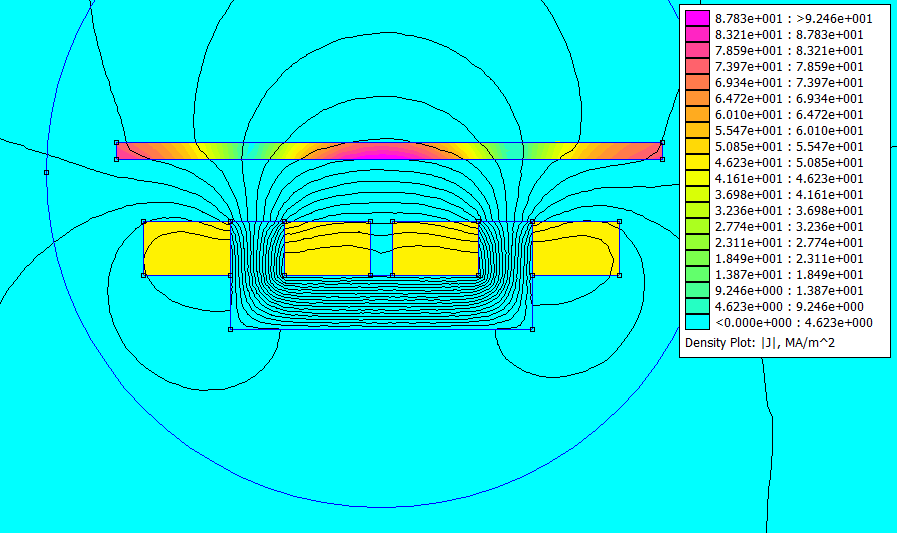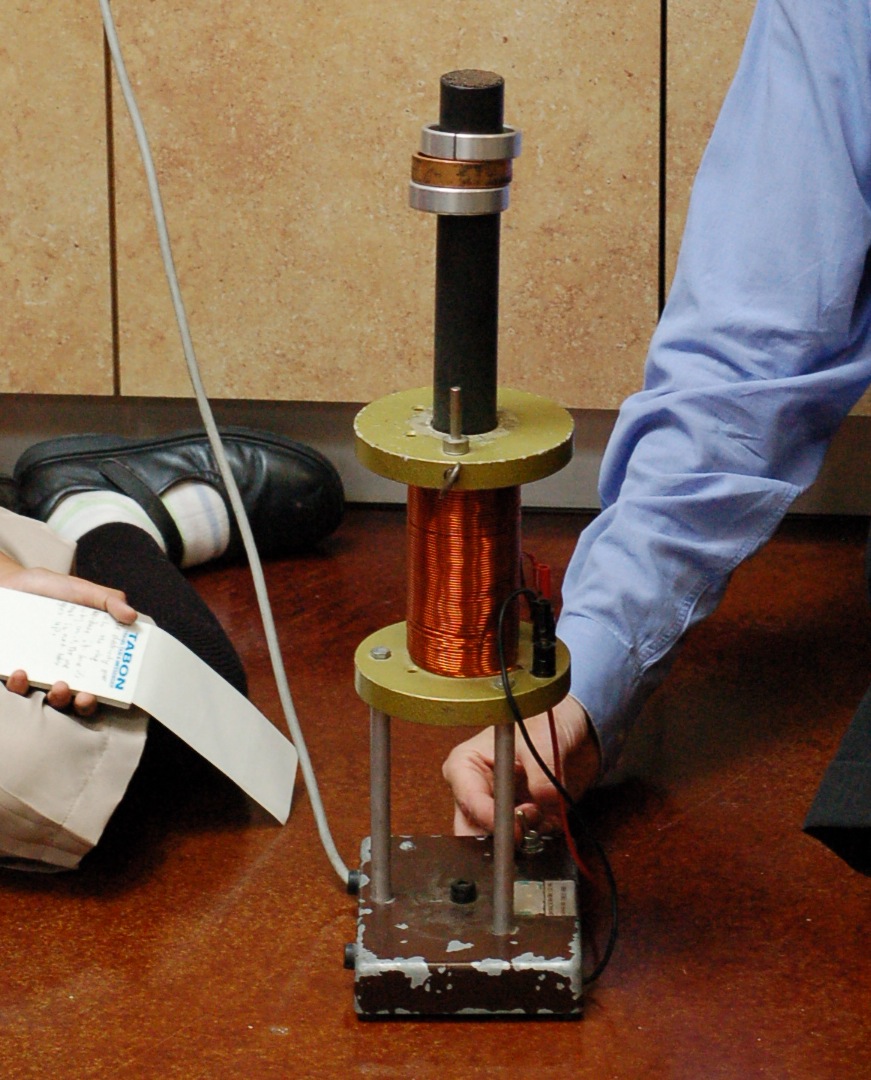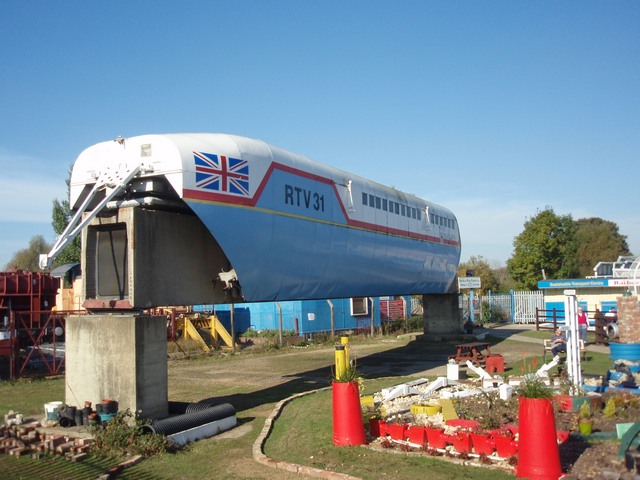|
Magnetic River
Magnetic river is an electrodynamic magnetic levitation (maglev) system designed by Fredrick Eastham and Eric Laithwaite in 1974. It consists of a thin conductive plate on an AC linear induction motor. Due to the transverse flux and the geometry, this gives it lift, stability and propulsion as well as being relatively efficient. The name refers to the action that provides stability along the longitudinal axis, which acts similar to the flow of water in a river. Linear motors A linear induction motor (LIM) is essentially a conventional induction motor with its primary "unwound" and laid out flat. The rotor, normally consisting of a series of conductors wound onto a form of some sort, is replaced by a sheet of magnetically susceptible metal. Due to its good conductance to weight ratio, aluminium is almost always used for this "stator plate". When the primaries are fed current, they induce a magnetic field in the stator plate, which generates forces away from the plate and along it. ... [...More Info...] [...Related Items...] OR: [Wikipedia] [Google] [Baidu] |
Electrodynamic Suspension
Electrodynamic suspension (EDS) is a form of magnetic levitation in which there are conductors which are exposed to time-varying magnetic fields. This induces eddy currents in the conductors that creates a repulsive magnetic field which holds the two objects apart. These time varying magnetic fields can be caused by relative motion between two objects. In many cases, one magnetic field is a permanent field, such as a permanent magnet or a superconducting magnet, and the other magnetic field is induced from the changes of the field that occur as the magnet moves relative to a conductor in the other object. Electrodynamic suspension can also occur when an electromagnet driven by an AC electrical source produces the changing magnetic field, in some cases, a linear induction motor generates the field. EDS is used for maglev trains, such as the Japanese SCMaglev. It is also used for some classes of magnetically levitated bearings. Types Many examples of this have been used over the y ... [...More Info...] [...Related Items...] OR: [Wikipedia] [Google] [Baidu] |
Fredrick Eastham
Fredrick may refer to: * Fredrick (given name), a given name * Fredrick (surname), a surname * ''Fredrick'' (2016 film) See also * Frederick (other) Frederick may refer to: People * Frederick (given name), the name Nobility Anhalt-Harzgerode *Frederick, Prince of Anhalt-Harzgerode (1613–1670) Austria * Frederick I, Duke of Austria (Babenberg), Duke of Austria from 1195 to 1198 * Frederic ... * Fredricks {{Disambig ... [...More Info...] [...Related Items...] OR: [Wikipedia] [Google] [Baidu] |
Eric Laithwaite
Eric Roberts Laithwaite (14 June 1921 – 27 November 1997) was a British electrical engineer, known as the "Father of Maglev" for his development of the linear induction motor and maglev rail system. Biography Eric Roberts Laithwaite was born in Atherton, Lancashire, on 14 June 1921, raised in the Fylde, Lancashire and educated at Kirkham Grammar School. He joined the Royal Air Force in 1941. Through his service in World War II, he rose to the rank of Flying Officer, becoming a test engineer for autopilot technology at the Royal Aircraft Establishment in Farnborough. On demobilization in 1946, he attended the University of Manchester to study electrical engineering. His work on the Manchester Mark I computer earned him his master's degree. His subsequent doctoral work started his interest in linear induction motors. He derived an equation for " goodness" which parametrically describes the efficiency of a motor in general terms, and showed that it tended to imply that ... [...More Info...] [...Related Items...] OR: [Wikipedia] [Google] [Baidu] |
Linear Induction Motor
A linear induction motor (LIM) is an alternating current (AC), asynchronous linear motor that works by the same general principles as other induction motors but is typically designed to directly produce motion in a straight line. Characteristically, linear induction motors have a finite primary or secondary length, which generates end-effects, whereas a conventional induction motor is arranged in an endless loop. Despite their name, not all linear induction motors produce linear motion; some linear induction motors are employed for generating rotations of large diameters where the use of a continuous primary would be very expensive. As with rotary motors, linear motors frequently run on a three-phase power supply and can support very high speeds. However, there are end-effects that reduce the motor's force, and it is often not possible to fit a gearbox to trade off force and speed. Linear induction motors are thus frequently less energy efficient than normal rotary motors for a ... [...More Info...] [...Related Items...] OR: [Wikipedia] [Google] [Baidu] |
THE LIMTV (LINEAR INDUCTION MOTOR TEST VEHICLE) IS TESTED AT THE DEPARTMENT OF TRANSPORTATION'S HIGH SPEED GROUND
''The'' () is a grammatical article in English, denoting persons or things already mentioned, under discussion, implied or otherwise presumed familiar to listeners, readers, or speakers. It is the definite article in English. ''The'' is the most frequently used word in the English language; studies and analyses of texts have found it to account for seven percent of all printed English-language words. It is derived from gendered articles in Old English which combined in Middle English and now has a single form used with pronouns of any gender. The word can be used with both singular and plural nouns, and with a noun that starts with any letter. This is different from many other languages, which have different forms of the definite article for different genders or numbers. Pronunciation In most dialects, "the" is pronounced as (with the voiced dental fricative followed by a schwa) when followed by a consonant sound, and as (homophone of pronoun ''thee'') when followed by a v ... [...More Info...] [...Related Items...] OR: [Wikipedia] [Google] [Baidu] |
Induction Motor
An induction motor or asynchronous motor is an AC electric motor in which the electric current in the rotor needed to produce torque is obtained by electromagnetic induction from the magnetic field of the stator winding. An induction motor can therefore be made without electrical connections to the rotor. An induction motor's rotor can be either wound type or squirrel-cage type. Three-phase squirrel-cage induction motors are widely used as industrial drives because they are self-starting, reliable and economical. Single-phase induction motors are used extensively for smaller loads, such as household appliances like fans. Although traditionally used in fixed-speed service, induction motors are increasingly being used with variable-frequency drives (VFD) in variable-speed service. VFDs offer especially important energy savings opportunities for existing and prospective induction motors in variable-torque centrifugal fan, pump and compressor load applications. Squirrel ... [...More Info...] [...Related Items...] OR: [Wikipedia] [Google] [Baidu] |
Imperial College London
Imperial College London (legally Imperial College of Science, Technology and Medicine) is a public research university in London, United Kingdom. Its history began with Prince Albert, consort of Queen Victoria, who developed his vision for a cultural area that included the Royal Albert Hall, Victoria & Albert Museum, Natural History Museum and royal colleges. In 1907, Imperial College was established by a royal charter, which unified the Royal College of Science, Royal School of Mines, and City and Guilds of London Institute. In 1988, the Imperial College School of Medicine was formed by merging with St Mary's Hospital Medical School. In 2004, Queen Elizabeth II opened the Imperial College Business School. Imperial focuses exclusively on science, technology, medicine, and business. The main campus is located in South Kensington, and there is an innovation campus in White City. Facilities also include teaching hospitals throughout London, and with Imperial College Healthcare ... [...More Info...] [...Related Items...] OR: [Wikipedia] [Google] [Baidu] |
Transformer
A transformer is a passive component that transfers electrical energy from one electrical circuit to another circuit, or multiple circuits. A varying current in any coil of the transformer produces a varying magnetic flux in the transformer's core, which induces a varying electromotive force (EMF) across any other coils wound around the same core. Electrical energy can be transferred between separate coils without a metallic (conductive) connection between the two circuits. Faraday's law of induction, discovered in 1831, describes the induced voltage effect in any coil due to a changing magnetic flux encircled by the coil. Transformers are used to change AC voltage levels, such transformers being termed step-up or step-down type to increase or decrease voltage level, respectively. Transformers can also be used to provide galvanic isolation between circuits as well as to couple stages of signal-processing circuits. Since the invention of the first constant-potential transfo ... [...More Info...] [...Related Items...] OR: [Wikipedia] [Google] [Baidu] |
Maglev
Maglev (derived from '' magnetic levitation''), is a system of train transportation that uses two sets of electromagnets: one set to repel and push the train up off the track, and another set to move the elevated train ahead, taking advantage of the lack of friction. Such trains rise approximately off the track. There are both high speed, intercity maglev systems (over ), and low speed, urban maglev systems ( to ) being built and under construction and development. With maglev technology, the train travels along a guideway of electromagnets which control the train's stability and speed. While the propulsion and levitation require no moving parts, the bogies can move in relation to the main body of the vehicle and some technologies require support by retractable wheels at low speeds under . This compares with electric multiple units that may have several dozen parts per bogie. Maglev trains can therefore in some cases be quieter and smoother than conventional trains and have t ... [...More Info...] [...Related Items...] OR: [Wikipedia] [Google] [Baidu] |
Germany
Germany,, officially the Federal Republic of Germany, is a country in Central Europe. It is the second most populous country in Europe after Russia, and the most populous member state of the European Union. Germany is situated between the Baltic and North seas to the north, and the Alps to the south; it covers an area of , with a population of almost 84 million within its 16 constituent states. Germany borders Denmark to the north, Poland and the Czech Republic to the east, Austria and Switzerland to the south, and France, Luxembourg, Belgium, and the Netherlands to the west. The nation's capital and most populous city is Berlin and its financial centre is Frankfurt; the largest urban area is the Ruhr. Various Germanic tribes have inhabited the northern parts of modern Germany since classical antiquity. A region named Germania was documented before AD 100. In 962, the Kingdom of Germany formed the bulk of the Holy Roman Empire. During the 16th ce ... [...More Info...] [...Related Items...] OR: [Wikipedia] [Google] [Baidu] |
Tracked Hovercraft
Tracked Hovercraft was an experimental high speed train developed in the United Kingdom during the 1960s. It combined two British inventions, the hovercraft and linear induction motor, in an effort to produce a train system that would provide inter-city service with lowered capital costs compared to other high-speed solutions. Substantially similar to the French Aérotrain and other hovertrain systems of the 1960s, Tracked Hovercraft suffered a similar fate to these projects when it was cancelled as a part of wide budget cuts in 1973. History Genesis at Hovercraft Development It was noticed early on in the development of the hovercraft that the energy needed to lift a vehicle was directly related to the smoothness of the surface on which it travelled. This was not entirely surprising; the air trapped under the hovercraft will remain there except where it leaks out where the lifting surface contacts the ground — if this interface is smooth, the amount of leaked air will b ... [...More Info...] [...Related Items...] OR: [Wikipedia] [Google] [Baidu] |
Transpo '72
U.S. International Transportation Exposition, better known as Transpo '72, was a trade show held on of land at Dulles International Airport outside Washington, D.C., for nine days from May 27 to June 4, 1972. The $10 million event, sponsored by the U.S. Department of Transportation, was a showcase for all sorts of transportation-related technologies. Over a million visitors flocked to the show from all over the world. According to the ''Wall Street Journal'', it was "the biggest show the government has put on since World War II."Rothschild 1972 Transpo hosted the world's largest air show, all of the new widebody airliners, high-speed trains and demonstrations of the latest automated guideway transit systems. In addition to featuring futuristic technology "Flying trains, square dancing helicopters and the fantasy of a wonderland," according to a news release, Transpo '72 covered all current modes of transportation as well. General Manager William J. Bird explained, "We want to emp ... [...More Info...] [...Related Items...] OR: [Wikipedia] [Google] [Baidu] |




.png)



